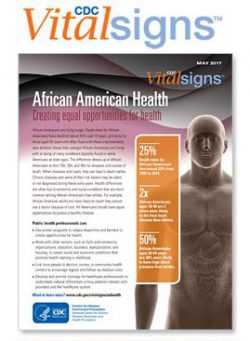Previous Health Equity Matters Newsletter
Features
CDC Vital Signs: African American Death Rate Drops; Health Gaps Still Persist

The death rate for African Americans (blacks) declined 25 percent from 1999 to 2015, according to a new CDC Vital Signs report. But disparities still persist between blacks and whites. Although blacks as a group are living longer, their life expectancy is still 4 years less than that of whites.
Disparities in all age groups are narrowing because death rates are declining faster among blacks than among whites. The overall disparity in death rates between these two races for all causes of death in all age groups was 33 percent in 1999 but fell to 16 percent in 2015. The racial death rate gap closed completely for deaths from heart disease and for all causes of death among those 65 years and older.
Of concern, the study also found that blacks in their 20s, 30s, and 40s are more likely to live with or die from conditions that typically occur at older ages in whites, including heart disease, stroke, and diabetes. Risk factors for some diseases, such as high blood pressure, may go unnoticed and untreated during these early years. Notably, the death rates for homicide among blacks did not change over the 17 years of the study.
The report also describes improvements in other causes of death, such as a dramatic decrease of about 80 percent in HIV deaths among 18- to 49-year-olds from 1999-2015. Dramatic drops in HIV deaths were also seen among whites. Still, a wide disparity remains with blacks seven to nine times more likely to die from HIV.
“We have seen some remarkable improvements in death rates for the black population in these past 17 years. Important gaps are narrowing due to improvements in the health of the black population overall. However, we still have a long way to go,” said Leandris Liburd, Ph.D., M.P.H., M.A., associate director, CDC’s Office of Minority Health and Health Equity. “Early health interventions can lead to longer, healthier lives. In particular, diagnosing and treating the leading diseases that cause death at earlier stages is an important step for saving lives.”
Social and economic conditions, such as poverty, contribute to gaps in health differences between blacks and whites, according to the report. In all age groups, the analysis showed that blacks had lower educational attainment and home ownership and nearly twice the rate of poverty and unemployment as whites. These risk factors may limit blacks’ access to prevention and treatment of disease. Other risk factors that affect health outcomes for blacks include obesity and less physical activity.
CDC researchers analyzed data from the U.S. Census Bureau, National Vital Statistics System, and CDC’s Behavioral Risk Factor Surveillance System (BRFSS) to examine factors that may influence disparities across the life span.
Among the key findings from the report:
- Blacks ages 18 to 64 are at higher risk of early death than whites.
- Disparities in the leading causes of death for blacks compared with whites are pronounced by early and middle adulthood, including homicide and chronic diseases such as heart disease and diabetes.
- Blacks ages 18-34 years and 35-49 years are nine times and five times, respectively, as likely to die from homicide as whites in the same age groups.
- Blacks ages 35-64 are 50 percent more likely to have high blood pressure than whites.
- Blacks ages 18-49 years, are two times as likely to die from heart disease than whites.
- Blacks have the highest death rate for all cancers combined compared with whites.
“It is important that we continue to create opportunities for all Americans to pursue a healthy lifestyle,” said Timothy Cunningham, Sc.D., lead author and epidemiologist with the Division of Population Health, CDC. “Public health professionals must work across all sectors to promote health at early ages.”
Public health agencies and community organizations should continue to implement programs proven to reduce health disparities, and partner with other sectors, including education, business, transportation, and housing, to create social and economic conditions that promote health starting in childhood to continue to close the gap in health outcomes. Proven prevention measures such as healthy eating, physical activity, tobacco cessation, disease screenings, and medication adherence remain important to reduce disease and early death.
The Federal government collects data on prevention measures and risk factors that impact health through programs such as Healthy People 2020. For more information on CDC efforts to reduce disparities through prevention and removing barriers to health equity, visit www.cdc.gov/healthequity.
Public Health Ethics Forum Explores Women’s Health throughout the Lifespan
The 2017 Public Health Ethics Forum: Optimal Health for Her Whole Life focused on promoting and protecting women’s health across the lifespan. The National Center for Bioethics in Research and Health Care at Tuskegee University and CDC’s Office of Minority Health and Health Equity co-hosted the annual event on May 19, 2017. Women’s health was chosen as the topic to address a range of health issues and actions to improve the health of women and girls in the United States with an emphasis on public health ethics. According to the Stanford Encyclopedia of Philosophy, public health ethics deals primarily with the moral foundations and justifications for public health, the various ethical challenges raised by limited resources for promoting health, and real or perceived tensions between collective benefits and individual liberty.
The 2017 forum participants discussed topics and shared resources that support the health of women and girls, and strategies for including them in the design and implementation of public health interventions. This type of inclusion is consistent with a public health ethics approach to women’s health. Being sensitive to ethics in public health research and practice requires that we ask specific questions of the work that is being done. For example, how can we balance the values and beliefs of stakeholders (e.g., women, families, healthcare providers, policymakers, employers) with good public health practice?
After a warm welcome from both CDC and Tuskegee University speakers, the opening plenary session featured Vivian Pinn, MD, former Director of the NIH Office of Research on Women’s Health, to give an overview of the history of women’s health and why attention to sex and gender differences and disparities and inequalities among populations of women is still an important focus of public health and clinical research. Dr. Pinn’s presentation provided the context for all that would be discussed during the Forum. Following her presentation, a panel discussion titled “Women’s Health at the Intersection of Context, Inclusion, and Public Health Practice” engaged the audience in a multi-disciplinary conversation on ways we can work toward improving health outcomes among women and girls. Dázon Dixon Diallo, DHL, MPH of Sister Love moderated the session featuring Judith Monroe, MD, FAAFP of the CDC Foundation, Maria Lourdes Reyes, MD, MPH of Project Concern International, Rosetta Ross, PhD from Spelman College, and Kathleen Yep, PhD, MA from Pitzer College (of the Claremont Colleges).
The 2017 forum participants then formed concurrent break-out sessions to tackle several issues including chronic diseases, preventing the spread of HIV and other sexually transmitted infections, reducing violence against women and girls, and improving social and economic factors that affect women’s health (e.g., education and income). Keep an eye out for an upcoming special edition of the Journal of Healthcare, Science and the Humanities that will feature articles capturing the plenary presentations, the panel discussion, and key themes and strategies that emerged from the concurrent break-out sessions.
The forum concluded with a closing message from Melanie Nadeau, PhD, MPH, Director of the American Indian Public Health Resource Center at North Dakota State University. Dr. Nadeau discussed the importance of public health ethics through her personal experience as a member of the Turtle Mountain Band of Chippewa. To continue to move forward, Dr. Pinn said it best, “Efforts must continue to provide advances in basic knowledge, prevention strategies, effective information dissemination, and more effective cures and interventions, always keeping in mind ethical principles and common sense approaches for health equity.”
The 2017 Public Health Ethics Forum is the first to focus on the health of women and girls and was timed to correspond with the culmination of National Women’s Health Week. Visit the 2017 Public Health Ethics Forum website for more information, including the forum’s reading list and speaker bios.
Health Equity Champion

Hazel D. Dean, MPH, ScD, DrPH (hon), FACE
Deputy Director, National Center for HIV/AIDS, Viral Hepatitis, STD, and TB Prevention (NCHHSTP), U.S. Centers for Disease Control and Prevention, Atlanta, Georgia
Dr. Hazel D. Dean has extensive experience in public health research, surveillance, program planning and implementation, management, policy, and workforce development. She has served at the state, local, federal, and international levels and at nonprofit organizations. Dean is now the deputy director of the National Center for HIV/AIDS, Viral Hepatitis, STD, and TB Prevention (NCHHSTP), the lead federal center for preventing and controlling HIV/AIDS, viral hepatitis, sexually transmitted diseases, and tuberculosis.
Dean is internationally recognized for her work in health disparities and health equity research and policy. She has authored over 100 peer-reviewed journal articles, policy reports, and other publications about infectious and chronic diseases, public health surveillance, applied epidemiologic methods, social and structural determinants of health, and the public health workforce. She frequently serves on national and international advisory groups and committees addressing infectious and chronic diseases among underserved populations.
“History has taught us that health disparities can be substantially reduced or eliminated through a combination of preventive services for everyone and preventive services that target the greatest needs of disadvantaged populations with sufficient resources to address those needs,” said Dean. “Only by addressing the need for a diverse public health workforce and reducing existing health disparities can we begin to achieve our goal of public health equity.”
Among Dean’s numerous honors are the Presidential Rank Honor Award for Distinguished Service (2012) and the U.S. Department of Health and Human Services’ Distinguished Service Award (2013), two of the nation’s highest civilian awards. In 2014, she received an honorary doctorate in public health from Spelman College for her distinguished international leadership in addressing health disparities. She also was elected a Fellow of the American College of Epidemiology that year for her substantial and sustained contributions to that field of research. Dr. Dean earned her BS in biology (Spelman College), her MPH in international health/biostatistics, and her ScD in biostatistics (both, Tulane University).
“One of my goals, as well as that of my center, is achieving health equity-meaning that all people have an equal chance to be healthy, regardless of their race/ethnicity, income, sex, religion, sexual orientation, gender identity, or disability,” said Dean.
You can follow Dr. Dean on Twitter: @DrDeanCDC and learn more about the National Center for HIV/AIDS, Viral Hepatitis, STD, and TB Prevention.
- Page last reviewed: May 25, 2017
- Page last updated: May 25, 2017
- Content source:


 ShareCompartir
ShareCompartir